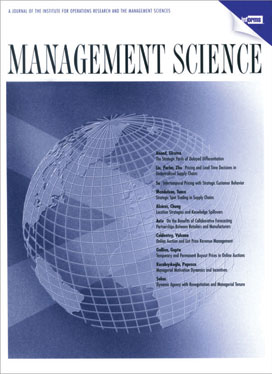Academic articles
Practitioner articles
Working papers
Books
Book chapters
Case studies
Other publications
Subject(s)
Marketing
Keyword(s)
Theory development, unit of analysis, consumer acculturation, nostalgia, consumption culture
JEL Code(s)
M31
Volume
42
Journal Pages
255–259
Subject(s)
Economics, politics and business environment; Health and environment
Volume
49
Journal Pages
47–53
Subject(s)
Economics, politics and business environment
JEL Code(s)
L40, L50, K21
Volume
10
Journal Pages
293–339
Subject(s)
Human resources management/organizational behavior
Keyword(s)
error management, teams
Crisis management teams occupy central roles in many normative models of crisis management; however, management education generally address neither the nature of such teams nor the capabilities necessary for these teams to be effective. To help address this situation, in this paper we integrate information from phase-based crisis management models with team dynamics theories, and suggest which team capabilities play key roles for crisis management teams as they face emergent crises. Using this integration, we then explore simulation-based training as a means to teach and assess crisis management team capabilities. We describe the design, development and implementation of a simulation for crisis teams, and discuss future applications of simulation-based training for crisis management education.
With permission of the Academy of Management
Volume
13
Journal Pages
208–221
ISSN (Online)
1944-9585
ISSN (Print)
1537-260X
Subject(s)
Technology, R&D management
Keyword(s)
Open innovation, attention, suggestions, ideation, openness, user innovation, success bias, social media
This paper analyzes organizations’ attempts to entice external contributors to submit suggestions for future organizational action. While earlier work has elaborated on the advantages of leveraging the knowledge of external contributors, our findings show that organizational attempts to attract such involvement are more likely to wither or die. We develop arguments about what increases the likelihood of getting suggestions from externals in the future, namely through (1) proactive attention (submitting internally developed suggestions to externals to stimulate debate); and (2) reactive attention (paying attention to suggestions from externals to signal they are being listened to), particularly when those suggestions are submitted by newcomers. Findings from an analysis of about 24,000 initiatives by organizations to involve external contributors suggest these actions are crucial for receiving suggestions from external contributors. Our results are contingent upon the stage of the initiative because organizations’ actions exert more influence in initiatives that lack a history of prior suggestions. Our work has implications for scholars of open innovation because it highlights the importance of considering failures as well successes: focusing exclusively on initiatives that reach a certain stage can lead to partial or erroneous conclusions about why some organizations engage external contributors while others fail.
With permission of Elsevier
Volume
43
Journal Pages
812–827
Subject(s)
Strategy and general management
Keyword(s)
Strategic management, strategy Evolution.
Volume
13
Journal Pages
8–18
Subject(s)
Strategy and general management; Technology, R&D management
Keyword(s)
Co-authorship, academic partnership, joint research, joint publication, asymmetric authorship, benefits sharing
Partnerships can be found in many areas of social and economic life. These arrangements have become particularly common in research and development activities where organizations increasingly look for partners to complement their own technological capabilities with a view to create innovative products and processes. R&D partnerships, however, are fraught with challenges because the conditions for creativity through cooperation are still not fully understood. Academic partnerships are also very common and offer a fertile ground for investigation. Academic cooperation takes many different forms and results in a wide range of outcomes (Laband and Tollison, 2000). One of the most visible outcomes is co-authored publications (Melin and Persson, 1996). Nowadays, there is extensive data available about both the context of these partnerships as well as the quality of their outcome. This paper explores the determinants of the gain for authors who cooperate through co-authorship in the publication of academic articles. We distinguish between short-term benefits (i.e. the increase in citations of the co-authored article relative to the authors’ previous publications) and the long-term ones (i.e. the increase in citations of articles subsequent to the co-authored piece). We find evidence that these benefits have different determinants for co-authors depending on their past experience. While co-authorship generally seems to benefit more the junior (younger and with a lower academic reputation) author, the senior partner can reduce the gap with a strong personal track record and co-authoring experience.
With permission of Elsevier
Volume
43
Journal Pages
1002–1013
Subject(s)
Ethics and social responsibility; Marketing
Keyword(s)
Corporate social responsibility, organizational identification, customer orientation, job performance
A study involving a Global 500 company finds that frontline employees’ perceptions of corporate social responsibility (CSR) can contribute to their customer orientation (self-rated) and objective job performance (supervisor-rated) by activating social identification processes. Employees identify with the organization based in part on the extent to which CSR is supported by salient and job-relevant others both internal and external to the organization. Looking internally, employees identify with the organization to the extent that they perceive management to support CSR. Looking externally, employees can identify with customers (called employee-customer identification) to the extent they perceive customers to support the company’s CSR. Both effects are enhanced when employees feel CSR is an important (versus non-important) part of their self-concept. Organizational identification directly drives job performance while employee-customer identification contributes to job performance through its effects on organizational identification and customer orientation.
With the permission of the American Marketing Association
Volume
78
Journal Pages
20–37
Subject(s)
Product and operations management
Keyword(s)
Revenue management, pricing, coordination, price-sensitive stochastic demand, hierarchical policies, lost sales rate elasticity
The integration of systems for pricing and revenue management must trade off potential revenue gains against significant practical and technical challenges. This dilemma motivates us to investigate the value of coordinating decisions on prices and capacity allocation in a stylized setting. We propose two pairs of sequential policies for making static decisions—on pricing and revenue management—that differ in their degree of integration (hierarchical versus coordinated) and their pricing inputs (deterministic versus stochastic). For a large class of stochastic, price-dependent demand models, we prove that these four heuristics admit tractable solutions satisfying intuitive sensitivity properties. We further evaluate numerically the performance of these policies relative to a fully coordinated model, which is generally intractable. We find it interesting that near-optimal performance is usually achieved by a simple hierarchical policy which sets prices first, based on a non-nested stochastic model, and then uses these prices to optimize nested capacity allocation. This tractable policy largely outperforms its counterpart based on a deterministic pricing model. Jointly optimizing price and allocation decisions for the high-end segment improves performance, but the largest revenue benefits stem from adjusting prices to account for demand risk.
© 2014 INFORMS
Volume
60
Journal Pages
730–752
ISSN (Online)
1526-5501
ISSN (Print)
0025–1909
Subject(s)
Human resources management/organizational behavior
Keyword(s)
Organizational behavior, psychology, error management, safety
Volume
1
Journal Pages
23–43


